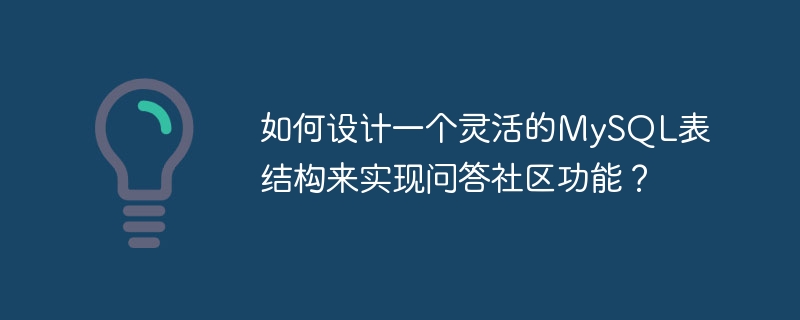Home >Database >Mysql Tutorial >How to design a flexible MySQL table structure to implement the Q&A community function?
How to design a flexible MySQL table structure to implement the Q&A community function?
- 王林Original
- 2023-10-31 10:40:54726browse

How to design a flexible MySQL table structure to implement the Q&A community function?
With the rapid development of the Internet, Q&A communities have become an important platform for people to obtain knowledge and exchange experiences. To realize a fully functional Q&A community, good database design is a crucial step. MySQL is a widely used relational database management system. This article will introduce how to design a flexible MySQL table structure to implement the Q&A community function.
In order to realize the function of the Q&A community, we need to design the following main tables: user table, question table, answer table, comment table, tag table and like table.
The user table is the core of the Q&A community and is used to store user-related information. We can design a table named "users" that contains the following fields:
CREATE TABLE users (
id INT AUTO_INCREMENT PRIMARY KEY,
username VARCHAR(50) NOT NULL,
email VARCHAR(100) NOT NULL,
password VARCHAR(100) NOT NULL,
created_at TIMESTAMP DEFAULT CURRENT_TIMESTAMP
);The question table is used to store questions posted by users. We can design a table named "questions" that contains the following fields:
CREATE TABLE questions (
id INT AUTO_INCREMENT PRIMARY KEY,
user_id INT NOT NULL,
title VARCHAR(200) NOT NULL,
content TEXT NOT NULL,
created_at TIMESTAMP DEFAULT CURRENT_TIMESTAMP,
FOREIGN KEY (user_id) REFERENCES users (id)
);The answer table is used to store users' answers to questions. We can design a table named "answers" that contains the following fields:
CREATE TABLE answers (
id INT AUTO_INCREMENT PRIMARY KEY,
user_id INT NOT NULL,
question_id INT NOT NULL,
content TEXT NOT NULL,
created_at TIMESTAMP DEFAULT CURRENT_TIMESTAMP,
FOREIGN KEY (user_id) REFERENCES users (id),
FOREIGN KEY (question_id) REFERENCES questions (id)
);The comment table is used to store user comments on questions or answers. We can design a table named "comments" that contains the following fields:
CREATE TABLE comments (
id INT AUTO_INCREMENT PRIMARY KEY,
user_id INT NOT NULL,
question_id INT,
answer_id INT,
content TEXT NOT NULL,
created_at TIMESTAMP DEFAULT CURRENT_TIMESTAMP,
FOREIGN KEY (user_id) REFERENCES users (id),
FOREIGN KEY (question_id) REFERENCES questions (id),
FOREIGN KEY (answer_id) REFERENCES answers (id)
);The tag table is used to store the tags of the question. We can design a table named "tags" that contains the following fields:
CREATE TABLE tags (
id INT AUTO_INCREMENT PRIMARY KEY,
name VARCHAR(50) NOT NULL
);Finally, the likes table is used to store the user's likes for questions, answers, or comments. We can design a table named "likes", containing the following fields:
CREATE TABLE likes (
id INT AUTO_INCREMENT PRIMARY KEY,
user_id INT NOT NULL,
question_id INT,
answer_id INT,
comment_id INT,
created_at TIMESTAMP DEFAULT CURRENT_TIMESTAMP,
FOREIGN KEY (user_id) REFERENCES users (id),
FOREIGN KEY (question_id) REFERENCES questions (id),
FOREIGN KEY (answer_id) REFERENCES answers (id),
FOREIGN KEY (comment_id) REFERENCES comments (id)
);Through the design of the above table structure, we can implement a flexible question and answer community function. With appropriate querying and indexing, users can easily browse and search questions, answers, and comments. In addition, users can also like questions, answers and comments to achieve interactive communication.
The above is a simple MySQL table structure design example for your reference. In actual applications, it can also be adjusted and optimized according to specific needs. I hope to be helpful!
The above is the detailed content of How to design a flexible MySQL table structure to implement the Q&A community function?. For more information, please follow other related articles on the PHP Chinese website!

